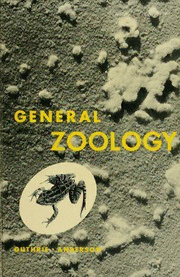
General zoology PDF
Preview General zoology
,.^ iL-u itS^ GENERAL ZOOLOGY ^f. '^'^^ \v > Mary Guthrie J. RESEARCH ASSOCIATE, EMERITUS, DETROIT INSTITUTE OF CANCER RESEARCH PROFESSOR OF BIOLOGY, WAYNE STATE UNIVERSITY ZOOLOGY John M. Anderson PROFESSOR OF ZOOLO(iV, C:ORNEI.L UNIVERSrr\- NEW YORK JOHN WILEY & SONS, INC. • London SECOND PRINTING, NOVEMBER, 1961 Copyright © 1957byJohnWiley&Sons, Inc. All rights reserved. This book or any part thereof must not be reproduced in any form withoutthewritten permission ofthe publisher. LibraryofCongressCatalogCard Number: 57-13444 PrintedintheUnitedStatesofAmerica PREFACE Curtis and Guthrie's Textbook of General ^oology has been a standard work in its field through three decades and four editions. The withdrawal of Pro- fessor Winterton C. Curtis from active participation in a further revision, together with the rapid development of many areas of zoological knowledge and interpretation, has made the preparation of an essentially new book preferable to the issuance of a fifth edition in the Curtis and Guthrie series. Nevertheless, those familiar with "Curtis and Guthrie" will immediately recognize how much this book owes to its predecessors, in content, organiza- tion, and emphasis. In general, we have endeavored to preserve the features of the Curtis and Guthrie texts that have proved successful in teaching prac- tice and to revise and amplify the parts that progress in zoology has made inadequate. This is not an easy, superficial book. We are convinced that giving the student an insight into the great depth and richness of zoology may awaken his interest and so fire his imagination and curiosity that he will find the subject worthy of further study. Even if he is a terminal student, contem- plating no studies in zoology beyond his introductory course, leading him into some of the more profound aspects of the subject will make his limited experience more rewarding. His textbook should not be one in which he merely performs assigned readings; he should have a book he can read with enjoyment, one that gives him a broad foundation and background for the sometimes narrow and necessarily restricted view ofzoology which he glimpses in classroom and laboratory. On the other hand, there are limits to the amount of factual information and learned terminology to which students should be subjected in introductory textbooks. We do not believe, as some zoologists do, that emphasis on anatomy, and on the phylogenetic relationships which can often be inferred from structural similarities, constitutes an outmoded approach to zoology. Although the most dynamic recent advances have stemmed from physiological studies, an understanding of structure is prerequisite to an appreciation of the functions of organisms. Our objective has been to write a book in which functional aspects are emphasized, but in which they are made coherent and intelligible by a full exposition of the anatomical features involved. Further, we have PREFACE attempted to combine factual information with the interpretations and con- clusions which the facts justify and which give point and meaning to the facts as presented. The approach of the present work, like that of the Curtis and Guthrie series, is to begin with the vertebrate type of organization, introducing the student to various aspects of structure and function in vertebrates and then proceeding to a stepwise consideration of how the vertebrate organization developed through evolution. The early chapters, although generally ori- ented toward the vertebrates, deal broadly and comparatively with such sub- jects as cellular structure and function and the universal aspects of metabolism and responsiveness. Accordingly, these chapters furnish an introduction to principles that apply throughout the Animal Kingdom. The organization of this book has been made flexible enough to permit different manners of presentation. A teacher may elect to follow the order ofthe chapters, or to begin with classification (Chapter 7), study the inverte- brate groups, and then return to the vertebrates. Depending on the organiza- — tion of his course, the teacher must decide when the general chapters those — dealing with classification, heredity, ecology, and evolution can be most appropriately integrated. The broadly comparative survey of invertebrate organ systems and vital functions (Chapter 17) may be particularly useful in courses taking formal notice of only a few of the invertebrate groups and will serve as a basis for broad comparisons ifonly vertebrates are studied in detail. To those teachers who favor a man-centered approach to zoology, the ex- tended treatment given the invertebrate groups in this book may seem un- warranted. To us it appears that since the vast majority of animals are invertebrates, to ignore them is to lose sight of man's relation to the animal world and ofthe teeming mass of more primitive types from which the verte- brates have so recently emerged. The chapters on invertebrate phyla do not merely form a systematic survey ofthe Animal Kingdom but present a careful analysis of each group, its significant structural and functional aspects, and its place in phylogeny. The unifying theme of this section of the book is the progression oflevels oforganization through evolution. The several chapters discussing the representative types of animals regularly include remarks on their activities and habitat relations. In addition, a separate chapter has been devoted to ecology. Here we discuss the short- range and long-range interactions between animals and their environments, the specific eff^ects of many environmental factors in determining the survival and distribution of animals, and the concepts of competition and the balance of nature. This material is, in part, a preparation for the following chapter in which the role of the environment in evolutionary change is discussed. We hope that this chapter on ecology fills the gap reported by many who have used the Curtis and Guthrie textbooks. A major problem on which there is little agreement among teachers of zoology has been aptlv termed "the chemistry dilemma." Students of be- ginning zoology commonly have little if any background in chemistry, yet
